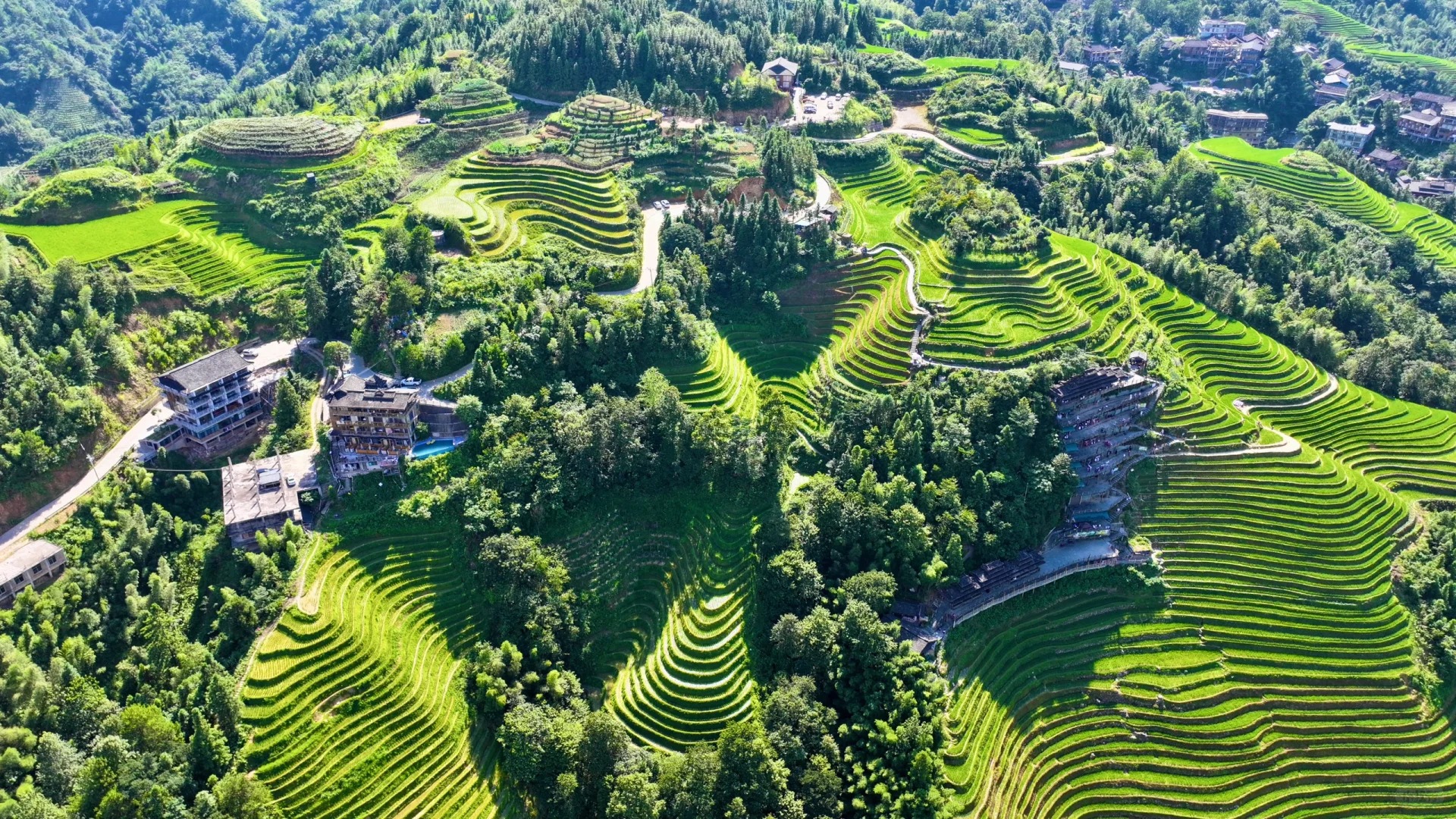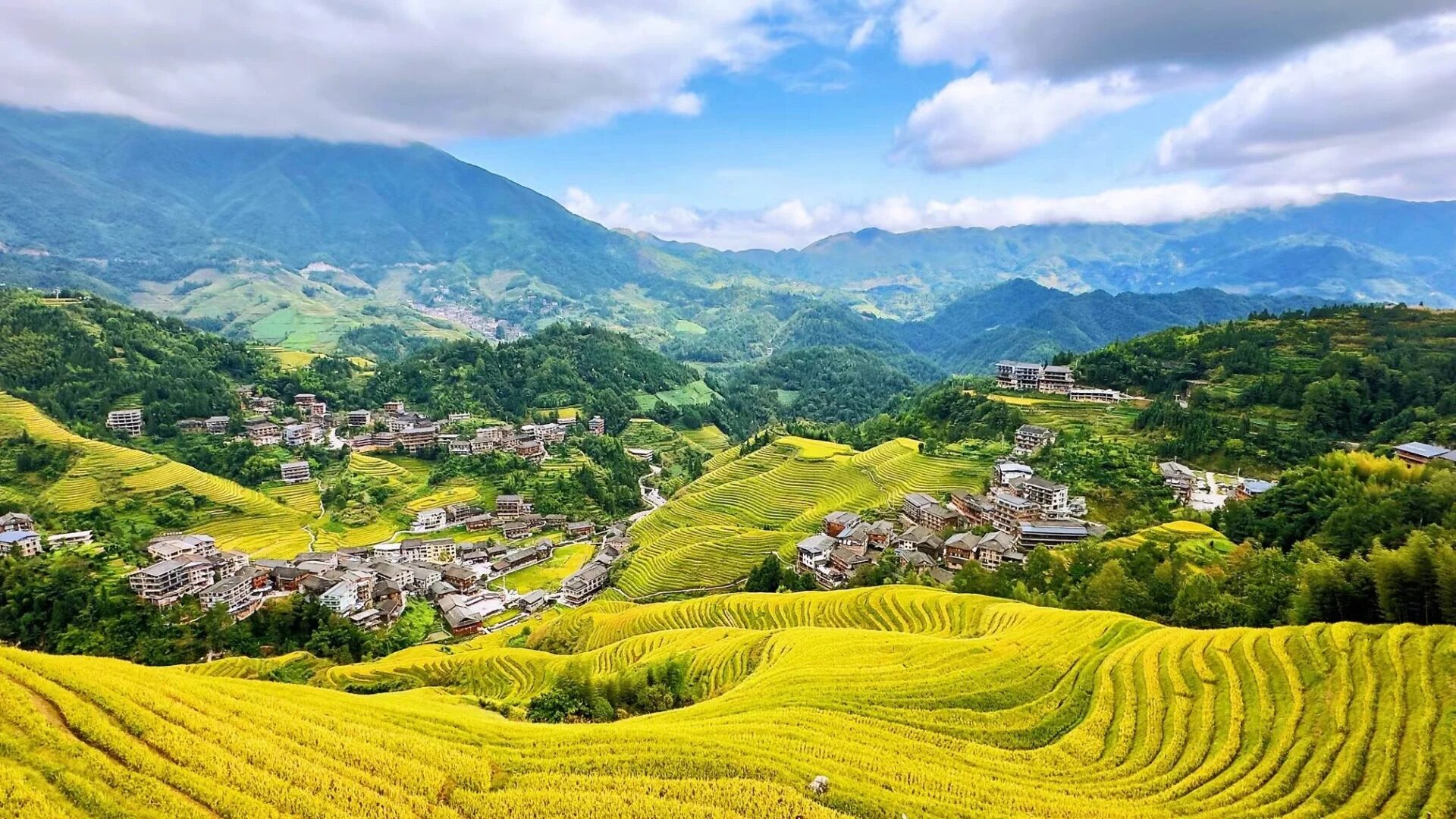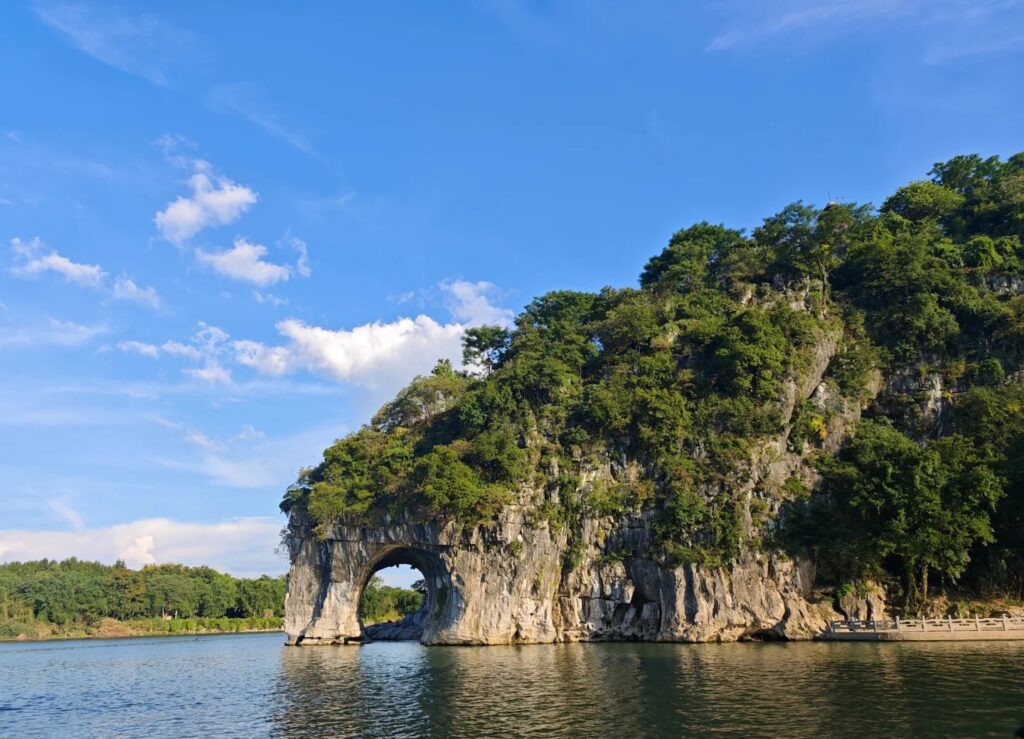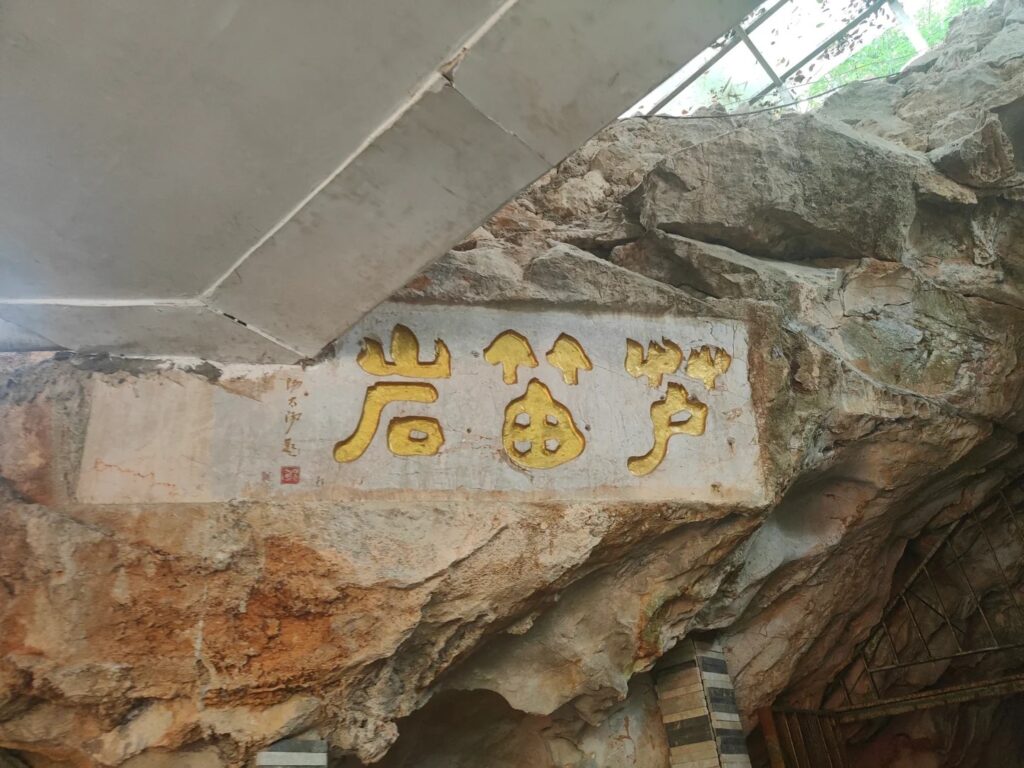Visiting Information
| Information | Details |
|---|---|
| Chinese Name | 龙脊梯田 (Lóngjǐ Tītián) |
| Location and Address | Longsheng County, Guilin City, Guangxi Zhuang Autonomous Region, China |
| Opening Time/Hours | Open all day, year-round |
| Entrance Fee | 95 CNY (April to October); 65 CNY (November to March) |
| How to Get There | By Bus: Take a bus from Guilin Qintan Bus Station to Longsheng, then transfer to a local bus to Ping’an or Dazhai village By Taxi: About 2.5 hours drive from Guilin city center |
| Best Time for Visit | April to October for lush green terraces; September to October for golden harvest views |
| Contact Info | +86 773 7583 266 |
Overview
The Longji Rice Terraces, also known as the Dragon’s Backbone Rice Terraces, are a marvel of agricultural engineering located in Longsheng County, Guangxi Province, China. These terraced fields snake along the contours of the Longji mountains, creating a stunning landscape that has become one of China’s most iconic rural vistas. The terraces were built by the local Zhuang and Yao ethnic minorities over centuries, transforming the steep mountainsides into productive farmland and a breathtaking scenic area.
Historical Background
The construction of the Longji Rice Terraces began during the Yuan Dynasty (1271-1368) and continued through the Ming Dynasty (1368-1644) and Qing Dynasty (1644-1911). The terraces were built by the local Zhuang and Yao people as a solution to cultivate rice on the steep mountain slopes. Over the centuries, the terraces have been continuously maintained and expanded, resulting in the vast network of terraced fields seen today. This ingenious agricultural system not only provided sustenance for the local communities but also created a unique cultural landscape that has endured for over 700 years.

Architectural Features
- Terraced Fields: The most prominent feature of Longji is its vast network of terraced rice fields. These terraces are built along the contours of the mountains, ranging from the foot to nearly the summit, covering an area of about 66 square kilometers. The terraces are supported by stone retaining walls and utilize an intricate irrigation system that maximizes water usage and prevents soil erosion.
- Traditional Villages: Scattered among the terraces are several traditional villages of the Zhuang and Yao ethnic minorities. These villages, such as Ping’an and Dazhai, feature traditional wooden stilt houses that are perfectly adapted to the steep terrain. The architecture of these villages reflects the unique culture and lifestyle of the local ethnic groups.
- Viewing Platforms: Several viewing platforms have been constructed at strategic points throughout the terraced landscape. These platforms, often reached by hiking trails, offer panoramic views of the rice terraces and surrounding mountains. Some of the most famous viewpoints include “Nine Dragons and Five Tigers,” “Seven Stars with the Moon,” and “A Thousand Layers to the Heaven.”
- Irrigation System: An intricate network of bamboo pipes and channels forms the irrigation system of the Longji Rice Terraces. This system efficiently distributes water from mountain springs and streams to each terrace level, ensuring that all fields receive adequate water for rice cultivation. The irrigation system is a testament to the ingenuity of the local farmers and their deep understanding of the landscape.
Cultural Importance
The Longji Rice Terraces are not just an agricultural marvel but also a living testament to the culture and traditions of the Zhuang and Yao ethnic minorities. These terraces represent centuries of harmonious interaction between humans and nature, showcasing sustainable agricultural practices that have been passed down through generations. The terraces are integral to the local way of life, influencing everything from daily routines to festivals and celebrations. They also serve as a powerful symbol of Chinese rural heritage, embodying the perseverance, ingenuity, and connection to the land that characterizes traditional Chinese agrarian culture.
Surrounding Attractions
- Longsheng Hot Springs: Located near the rice terraces, these natural hot springs offer a relaxing experience after a day of hiking. The springs are rich in minerals and are believed to have therapeutic properties. Visitors can enjoy both public and private pools, surrounded by beautiful mountain scenery. The hot springs are particularly popular during cooler months, providing a warm retreat amidst the crisp mountain air.
- Huangluo Yao Village: Known as the “Long Hair Village,” Huangluo is famous for the Yao women’s extraordinarily long hair, which can reach up to 1.7 meters in length. Visitors can learn about Yao customs, watch cultural performances, and witness the unique hairstyles of the local women. The village offers insights into traditional Yao architecture, clothing, and lifestyle, providing a cultural complement to the natural beauty of the rice terraces.
- Guilin City: About 80 kilometers south of the Longji Rice Terraces, Guilin is renowned for its dramatic landscape of limestone karst hills. Visitors can take a cruise on the Li River, explore the Reed Flute Cave, or climb Elephant Trunk Hill. The city also offers a variety of local cuisine and shopping opportunities, making it a popular base for exploring the wider region, including the rice terraces.
- Ping’an Zhuang Village: This traditional village within the rice terrace area offers a glimpse into the life of the Zhuang ethnic minority. Visitors can explore the wooden stilt houses, try local cuisine, and purchase traditional handicrafts. The village is also a starting point for many hiking trails through the rice terraces, offering both cultural experiences and natural beauty.

Photography Opportunities
- Sunrise and Sunset Views: The terraces offer spectacular views during sunrise and sunset, when the light creates a magical interplay of shadows and reflections on the water-filled terraces. Popular viewpoints for these shots include “Nine Dragons and Five Tigers” and “Seven Stars with the Moon.” The golden hour light enhances the contours of the terraces, creating a breathtaking landscape that’s a favorite among photographers.
- Seasonal Changes: Each season offers unique photographic opportunities. In spring, the water-filled terraces create mirror-like reflections of the sky. Summer brings lush green terraces full of growing rice. Autumn offers golden hues as the rice ripens before harvest. Even winter, with occasional snow, can create striking monochromatic scenes. Photographers can capture the ever-changing face of the landscape throughout the year.
- Cultural Portraits: The local Zhuang and Yao people, with their colorful traditional costumes and unique customs, offer excellent opportunities for portrait photography. Capturing the farmers working in the terraces or local women with their long hair provides a human element to the landscape shots, telling the story of the people who have shaped this land for centuries.
- Aerial Photography: For those with access to drones (where permitted), aerial photography reveals the true scale and intricate patterns of the terraces. The bird’s-eye view showcases the terraces’ resemblance to a giant staircase ascending the mountainsides, offering a perspective that’s impossible to capture from ground level.
Modern Importance
- Sustainable Agriculture Model: The Longji Rice Terraces serve as a model for sustainable mountain agriculture. The terracing technique prevents soil erosion, conserves water, and maximizes land use on steep slopes. In an era of increasing concern about sustainable food production, the terraces demonstrate how traditional farming methods can be both productive and environmentally friendly. Scientists and agricultural experts study these terraces to understand and potentially apply similar techniques in other mountainous regions.
- Cultural Preservation: As China rapidly modernizes, the Longji Rice Terraces play a crucial role in preserving the traditional culture and lifestyle of the Zhuang and Yao ethnic minorities. The terraces and surrounding villages provide a living museum of sorts, where ancient agricultural practices and cultural traditions continue to thrive. This preservation of intangible cultural heritage is vital for maintaining China’s cultural diversity and historical continuity.
- Eco-tourism Development: The Longji Rice Terraces have become a flagship for eco-tourism in China. The site demonstrates how rural areas can develop tourism sustainably, providing economic opportunities for local communities while preserving the natural environment and cultural heritage. This model of tourism development is being studied and replicated in other parts of China and beyond, showing how traditional landscapes can be both preserved and economically viable in the modern world.
- Climate Change Research: The Longji Rice Terraces serve as an important site for studying the impacts of climate change on traditional agricultural systems. Researchers monitor how changing weather patterns affect rice cultivation at different altitudes and how the terraces’ unique microclimate might mitigate some effects of global warming. This research is crucial for understanding how to adapt traditional farming methods to changing climate conditions, potentially informing agricultural practices worldwide.

FAQ
- What are the Longji Rice Terraces famous for?
The Longji Rice Terraces are famous for their stunning beauty and ingenious design. They are known for their vast scale, covering entire mountainsides, and their ability to transform with the seasons, offering different spectacular views throughout the year. - What’s inside the Longji Rice Terraces?
The Longji Rice Terraces consist of vast terraced fields built along the contours of steep mountains, traditional Zhuang and Yao villages, hiking trails, viewing platforms, and an intricate irrigation system. Visitors can explore the terraces, interact with local communities, and enjoy breathtaking views of the landscape. - Are the Longji Rice Terraces free?
No, the Longji Rice Terraces are not free to visit. There is an entrance fee that varies depending on the season, with higher prices during the peak tourist season from April to October. - Are the Longji Rice Terraces worth visiting?
Yes, the Longji Rice Terraces are definitely worth visiting. They offer a unique combination of natural beauty, cultural experience, and agricultural innovation. The stunning views, especially during sunrise and sunset, and the opportunity to learn about traditional farming methods and ethnic minority cultures make it a valuable destination. - What to do in the Longji Rice Terraces?
At the Longji Rice Terraces, you can hike through the terraced fields, visit traditional Zhuang and Yao villages, take photographs from various viewpoints, try local cuisine, learn about rice cultivation, purchase handicrafts, and potentially participate in seasonal activities like planting or harvesting rice (depending on the time of year). - How do I get to the Longji Rice Terraces in the local city?
To get to the Longji Rice Terraces from Guilin city:
1. By Bus: Take a bus from Guilin Qintan Bus Station to Longsheng County (about 2 hours), then transfer to a local bus to Ping’an or Dazhai village (about 1 hour).
2. By Car or Taxi: It’s about a 2.5-hour drive from Guilin city center to the Longji scenic area.
3. Organized Tour: Many travel agencies in Guilin offer day trips or multi-day tours to the Longji Rice Terraces. - How to visit the Longji Rice Terraces?
To visit the Longji Rice Terraces:
1. Plan to spend at least one full day, or ideally stay overnight to fully experience the area.
2. Wear comfortable hiking shoes as there’s a lot of walking on uneven terrain.
3. Start early to catch the morning mist over the terraces.
4. Visit the main viewpoints like “Nine Dragons and Five Tigers” for panoramic views.
5. Explore villages like Ping’an or Dazhai to experience local culture.
6. Consider hiring a local guide for better understanding of the area’s history and culture.
7. Try local cuisine in the villages.
8. Be prepared for changing weather conditions, especially if visiting during shoulder seasons.
9. Respect local customs and ask permission before photographing residents.





